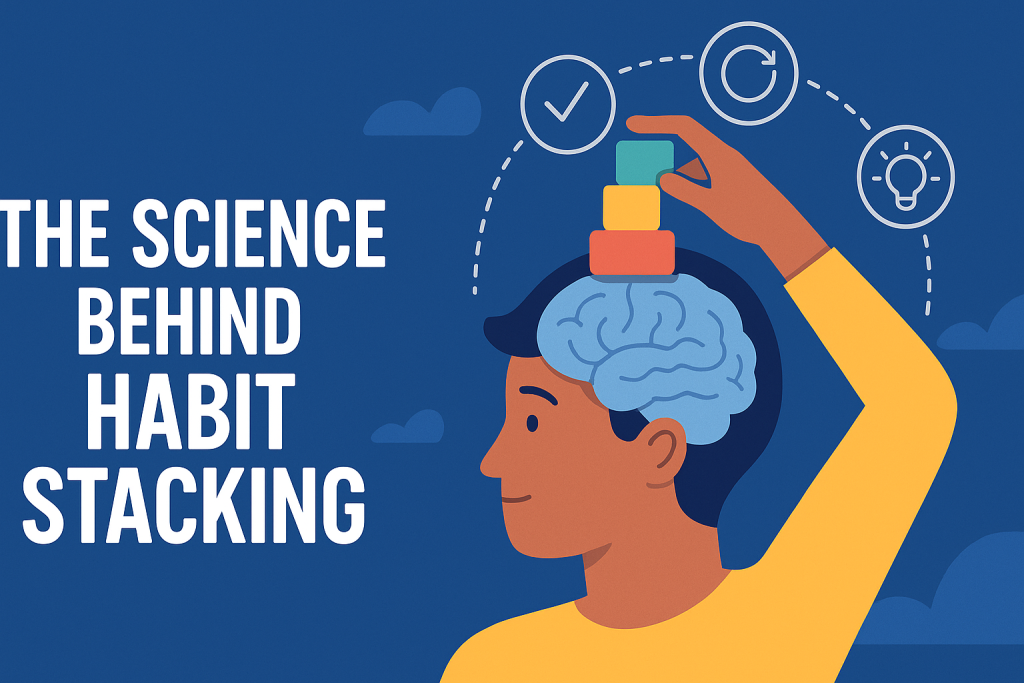In the pursuit of productivity and personal development, habit stacking has emerged as a pragmatic strategy grounded in behavioral science. It’s the idea of linking a new habit to an existing one, making change feel less disruptive and more automatic. This technique isn’t just a productivity hack—it’s now at the forefront of how behavioral scientists, app developers, and wellness platforms are designing tools for long-term habit change.
With advancements in behavioral technology and neuroscience, habit stacking is evolving from a self-help tip into a structured, data-driven practice. In the age of wearable devices, AI-based coaching, and real-time biofeedback, the science behind habit stacking is being validated and extended in ways that are reshaping how we form routines.

What Is Habit Stacking?
Habit stacking refers to a method of behavior design where you “stack” a new habit on top of a well-established one. Instead of relying on willpower or starting from scratch, you’re building on the neural pathways that are already deeply ingrained.
Example:
-
After I brew my morning coffee, I will review my to-do list.
-
After I brush my teeth at night, I will spend 5 minutes stretching.
This approach works because it leverages the cue-routine-reward loop described in Charles Duhigg’s model of habit formation. It reduces the friction of initiating a new behavior by tying it to a reliable trigger.
The Neuroscience of Habit Formation
At the neurological level, habits are encoded in the basal ganglia, a brain region responsible for automated actions. When we engage in habit stacking, we’re essentially piggybacking on this existing neural efficiency.
Key mechanisms:
-
Cue association: Attaching a new behavior to a current one reinforces pattern recognition in the brain.
-
Dopamine response: When a stacked habit is successfully completed, the brain releases dopamine, reinforcing the entire behavior sequence.
-
Memory consolidation: Repetition of stacked behaviors moves them from short-term effort into long-term automaticity.
This alignment with the brain’s natural processes is why habit stacking has shown higher success rates compared to standalone habit formation attempts.
How Technology Is Enhancing Habit Stacking
In recent years, habit stacking has been integrated into various digital products that aim to support behavior change. Tech companies and app developers are now leveraging behavioral data, user analytics, and neuroscience to build features that encourage stacked routines.
1. Wearables and Biofeedback Loops
Devices like the Apple Watch, Fitbit, and Oura Ring can prompt users to engage in micro-habits by sensing physiological triggers such as heart rate, activity level, or sleep cycles.
Example:
A wearable may prompt a breathing exercise after detecting a high-stress moment—stacking a calming response onto a physiological cue.
2. App-Based Habit Templates
Apps like Streaks, Habitica, and Fabulous provide templates for stacked habits. They don’t just help users track actions—they nudge them to connect habits in logical sequences.
Example:
Instead of setting a goal to “drink water,” a user is guided to “drink water right after logging breakfast,” reinforcing habit association.
3. AI-Powered Behavioral Nudging
AI-driven platforms now analyze user behavior to recommend habit stacks based on patterns. For instance, if a user consistently journals before bed, the app may suggest adding 5 minutes of gratitude reflection to that routine.
This data-informed personalization is making habit stacking not just easier but more adaptive.
Emerging Trend: Habit Stacking Meets Workplace Optimization
Companies are starting to explore how habit stacking can improve employee productivity and wellness. Internal apps and Slack integrations are being designed to promote micro-routines throughout the workday.
For example:
-
After ending a Zoom meeting, prompt employees to write a quick reflection.
-
Stack a short walking break with email inbox review to reduce screen fatigue.
This isn’t just about individual productivity—it’s about building cultures of sustainable performance.
Best Practices for Implementing Habit Stacking
If you’re considering habit stacking in your own life—or developing a tool that helps others—here are key principles to follow:
-
Start with an anchor
Identify a reliable, non-negotiable habit that already exists in your routine. -
Keep the new habit small
Aim for micro-habits (1–2 minutes max) that are easy to execute. -
Use clear language
Frame your stack in an “After I [existing habit], I will [new habit]” format. -
Avoid stacking too many habits at once
Overcomplicating the chain can reduce follow-through. -
Track feedback loops
Whether via journal, app, or wearable, record completion to build reinforcement.
Real-World Example: How Habit Stacking Is Being Used in Digital Health
Digital health platforms are using habit stacking to help users manage chronic conditions, reduce stress, and stay consistent with medication or therapy.
For instance, an app for diabetes management might stack the habit of glucose tracking with a water reminder and a prompt to stretch—delivered as a sequence right after meals.
These intentional habit chains make routines easier to follow and more effective long-term.
What the Future Holds for Habit Stacking in Tech
As artificial intelligence and behavioral data collection advance, habit stacking will likely become more automated, more predictive, and more effective.
Here’s what’s emerging:
-
Contextual triggers in smart homes
Voice assistants like Alexa or Google Home may soon detect when you enter the kitchen and automatically suggest your morning stack. -
Behavioral APIs
These integrations could bring habit stacking into your work tools, scheduling apps, and health trackers simultaneously. -
Real-time course correction
Based on biofeedback, smart devices will adjust recommendations dynamically—such as suggesting rest instead of action when you’re fatigued.
By integrating environment, mood, and activity data, technology can create a truly personalized system for behavioral success.
Conclusion
Ultimately, habit stacking works because it aligns with how the brain prefers to operate—through association, repetition, and minimal effort. As technology becomes increasingly intelligent, it enables us to design our routines in ways that feel natural rather than forced.
Rather than viewing habits as standalone struggles, stacking turns them into systems. When routines are well-designed, success doesn’t rely on motivation—it flows from structure.
Therefore, habit stacking isn’t just a productivity tip; it’s a method supported by both science and emerging technology. As digital tools continue to evolve, this approach will only become more effective and more accessible.
References:
- Duhigg, Charles. The Power of Habit. Random House, 2012. https://charlesduhigg.com
- Fogg, B.J. Tiny Habits: The Small Changes That Change Everything. Houghton Mifflin Harcourt, 2019.
https://www.tinyhabits.com - Clear, James. Atomic Habits: An Easy & Proven Way to Build Good Habits & Break Bad Ones. Penguin Random House, 2018. https://jamesclear.com









